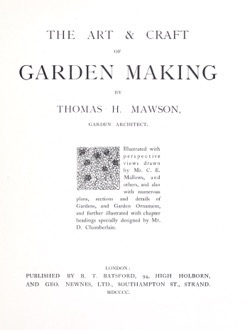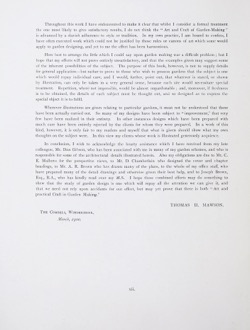Archive.org has a host of old gardening books (from mid-19th to mid-20th Century) available in many formats and on a host of topics. I happened across a few in my Pinterest feed and gone completely down the rabbit hole in this treasure trove of information. Sure some ideas might be out of
Historical Garden Books: The art & craft of garden making by Thomas Hayton Mawson – 28 in a Series
Download in Text, PDF, Single Page JPG, TORRENT from Archive.org
PREFACE.
GARDEN MAKING, it has been said, is the only art in which, owing to accidental development and unlooked-for groupings, the realisation surpasses in beauty the original conception. A caustic critic seizing upon this statement has referred to landscape gardening as an art which relies upon accident for its effects. Whilst not fully admitting the justice of this criticism, it must be allowed that the writings and practice of many men who have undertaken to lay out gardens, have given cause for it. The responsibility for this does not however, rest entirely with the landscape gardener, for no such desirable object as garden making has suffered so much from the inattention of those wh*o have been most capable of guiding and advising. This is the more remarkable when we consider the immense interest which has been taken in horticulture during the’ last fifty years.
Perhaps the explanation is to be found in the fact, that garden making had gradually fallen from its former high standing as an art, and was not considered to be the business of anybody in particular, least of all of those whose work it really ought to have been. How much this has lost to garden art, and, therefore, to the country generally, it is impossible to say ; but the garden designer desirous of doing something worthy of his aims, is made painfully aware how much his studies suffer for want of precedent. After he has done his best, his work lacks that harmoniousness which he naturally expects his subject to yield, and thus his education as a garden architect has to be very much a matter of experience, his best lessons being very often the outcome of his own failures.
Having, in the course of an extensive practice, had considerable opportunities for studying gardens, more especially garden design, in its relation to the house and its architectural character, I have realized the fact that one must be a compliment of the other. I can therefore, sympathise, on the one hand, with those architects who claim the right to design the setting or garden frame to the house they have designed, and, on the other hand, with those landscape gardeners who have felt, more especially in the later years of their practice, that to ensure a successful garden it is necessary that the designer has some say in the arrangement and disposal of the house on the site, and also in the selection of the site itself. In either case, however, the range of subjects which have to be mastered before this ideal can be reached, is so great, as to make many men shrink from undertaking it. By giving in a handy form some of the experience gained in the special department of garden design, I venture to hope that some of the difficulties, which now face architects who essay to design the gardens, will be considerably lessened. If I fail in this, I still hope to shew that garden designers are much more in sympathy with architectural ideals than recent writers would have it supposed.
The garden designer’s work, however, appeals to a much larger section than is included in the foregoing. It is not only those who are building new houses or adding to old ones who have to consider their surroundings ; owners of gardens are constantly requiring to re-model or re-adjust, especially where the original design has not been successful, whilst landed proprietors have always to be considering the changes which occur through the cutting or blowing down of timber on their estate, and to be making provision for the continuity of woodland effects. To such it is hoped the plans and sketches, with the accompanying descriptive matter, may be of use.
Throughout this work I have endeavoured to make it clear that whilst I consider a formal treatment the one most likely to give satisfactory results, I do net think the “ Art and Craft of Garden-Making ” is advanced by a slavish adherence to style or tradition. In my own practice, I am bound to confess, I have often executed work which could not be justified by those rules or canons of art which some would apply to garden designing, and yet to me the effect has been harmonious.
How best to arrange the little which I could say upon garden making was a difficult problem ; but I hope that my efforts will not prove entirely unsatisfactory, and that the examples given may suggest some of the inherent possibilities of the subject. The purpose of this book, however, is not to supply details for general application — but rather to prove to those who wish to possess gardens that the subject is one which would repay individual care, and I would, further, point out, that whatever is stated, or shewn by illustration, can only be taken in a very general sense, because each site would necessitate special treatment. Repetition, where not impossible, would be almost unpardonable ; and, moreover, if freshness is to be obtained, the details of each subject must be thought out, and so designed as to express the special object it is to fulfil.
Wherever illustrations are given relating to particular gardens, it must not be understood that these have been actually carried out. So many of my designs have been subject to “ improvement,” that very few have been realized in their entirety. In other instances designs which have been prepared with much care have been entirely rejected by the clients for whom they were prepared. In a work of this kind, however, it is only fair to my readers and myself that what is given should show what my own thoughts on the subject were. In this view my clients whose work is illustrated generously acquiesce.
In conclusion, I wish to acknowledge the hearty assistance which I have received from my late colleague, Mr. Dan Gibson, who has been associated with me in many of my garden schemes, and who is responsible for some of the architectural details illustrated herein. Also my obligations are due to Mr. C. E. Mallows for the perspective views, to Mr. D. Chamberlain who designed the cover and chapter headings, to Mr. A. R. Brown who has drawn many of the plans, to the whole of my office staff, who have prepared many of the detail drawings and otherwise given their best help, and to Joseph Brown, Esq., B.A., who has kindly read over my M.S. I hope these combined efforts may do something to shew that the study of garden design is one which will repay all the attention we can give it, and that we need not rely upon accidents for our effect, but may yet prove that there is both “ Art and practical Craft in Garden Making.”
THOMAS H. MAWSON.
The Corbels, Windermere,
March , 1900.
More information on this book:
* A portion of each sale from Amazon.com directly supports our blogs
** Many of these books may be available from your local library. Check it out!
† Available from the LA Public Library






